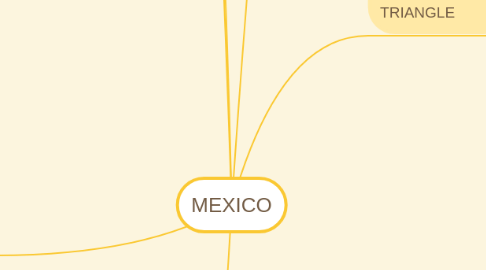
1. PRESIDENT ENRIQUE PEÑA NIETO
1.1. Government
1.1.1. U.S AGENDA: a lot of Bilateral mechanisms now exist to manage and guide policy cooperation across a range of areas
1.1.1.1. the economy, commerce, finance, public security, immigration, defense, the environment, education, science, and business collaboration
1.1.2. U.S- collaborating on trying to manage surging migrant flows
1.1.2.1. Also coordinated and worked closely to help address energy needs
1.2. U.S Perspective
1.2.1. Mexico is more actively participate in the multilateral handling of international issues in other regions of the world
1.2.2. Diplomats believe Mexico’s reasoned approach and resources could be beneficial to international coalitions
1.2.2.1. Such as in dealing with refugee challenges or in helping to fulfill international peacekeeping needs
1.3. The Road Ahead
1.3.1. NAFTA
1.3.1.1. Alternative efforts to construct a hemispheric and transpacific coalition of those open to free trade
1.3.1.2. Ensuring that their common border is more efficient in promoting commerce
1.3.1.3. Improving the efficient movement of people and goods across the US-Mexico, and the US-Canada
1.3.2. Border Adjustment Tax (BAT)
1.3.2.1. US of new investment in Mexico aimed at producing for the US market
1.3.3. All of this work on commerce and investment is vital for North America’s global competitiveness
1.3.4. Related is how the countries build new trade and investment bridges with other regions such as Europe
2. PRESIDENT VICENTE FOX
2.1. GOVERNMENT
2.1.1. Foreign governments should not judge, for good or bad, changes or events in governments in other nations
2.1.1.1. Because it could be seen to impinge on their sovereignty
2.1.2. Limited the ability of Mexico and the United States to collaborate on a range of foreign policy issues
2.1.2.1. Notably the human rights performance of another country
2.1.3. Demonstrate international leadership, winning a rotating seat on the UN Security Council
2.1.4. Also dispatched military personnel, a navy ship and civilian experts to help in disaster recovery
2.1.4.1. These endeavors generated more U.S.-Mexico dialogue
3. PRESIDENT CALDERON
3.1. Government
3.1.1. Inspired efforts to expand Mexico’s dialogues and outreach in Latin America, with Europe and with Asia
3.1.2. Increased funding for the Foreign Ministry
3.1.3. Established a small foreign assistance agency
3.1.3.1. Balanced comments on human rights with dialogues with Cuba
3.1.4. Agreed to a strategic dialogue with the European Union
3.1.5. Successfully launched a series of Free Trade Agreements
3.1.5.1. Has made Mexico the country with the greatest number of free trade partners in the world
3.1.6. Also launched the Pacific Alliance with free trade partners Colombia, Chile, and Peru
3.1.7. Greatly expanded practical U.S.-Mexico security and intelligence cooperation
3.1.7.1. Began cooperating much more closely on bilateral and international environmental issues
4. REFERENCES
4.1. Anthony Wayne E, 2017 Wilson Center Charting a New Course: Policy Options for the Next Stage in U.S.-Mexico Relations
5. THE NORTHERN TRIANGLE
5.1. FOREIGN POLICY
5.1.1. Mexico is the second largest customer of the United States in the world
5.1.2. Security collaboration
5.1.2.1. Has widened and deepened over the past fifteen years.
5.1.3. Would benefit from additional assistance from their northern neighbors
5.1.3.1. in fighting crime and poverty
5.1.3.2. in tackling the challenges of migration and refugee flows
5.1.3.3. in upgrading customs facilities and transportation corridors
5.1.3.4. in strengthening access to energy resources
5.1.4. Commitments and pledges
5.1.4.1. The Paris Climate Agreement
5.1.4.1.1. Maintaining the quality of the continental environment independently of the climate change issues
5.1.4.1.2. North America could become a serious energy power in the world for decades to come
5.1.4.1.3. Helping to reduce significantly dependence on energy resources from other areas of the globe
5.1.4.2. Summit meeting of the North American Leaders (NALS)
5.1.4.2.1. To build a wider range of cooperation on security issues
5.1.5. “Distant neighbors.”
5.1.5.1. Their coordination on foreign policy issues as well as bilateral affairs
5.1.5.2. North America Free Trade Agreement (NAFTA)
5.1.5.2.1. Mexico and the United States began a major shift in how they dealt with each other
5.1.6. International and Multilateral Coordination
5.1.6.1. A common deployment for disaster relief or peacekeeping should also be considered on the future agenda
5.1.6.1.1. This areas deserve concerted efforts bilaterally and trilaterally
5.1.6.2. Drug Policy
5.1.6.2.1. The meeting focused on the shared illicit drug problem, from production and trade to consumption and misuse
5.1.6.2.2. Must be a priority at the borders
5.1.6.3. They can mobilize the private sector, while sharing best practices with other regions of the globe
5.1.6.4. Development of all energy sources and the energy industries across the continent
5.1.7. New threats to security
5.1.7.1. Shared production and trading networks across North America and the increased threats of the weaponization of social media
5.1.7.2. The U.S.-Mexico military to military relationships were more distant
5.1.7.2.1. Have steadily improved over the last decade
5.1.8. The potential for common purpose
5.1.8.1. International issues where the United States and Canada are more natural partners as they are in NATO
5.1.8.2. Each of the three can enhance the security of their neighbors if they build, solidify
5.1.8.2.1. And improve cooperation and collaboration against threats like terrorism and crime
6. CENTRAL AMERICA
6.1. Mexico and the United States are collaborating to help strengthen Mexico’s national immigration service (IMS
6.1.1. Are coordinating efforts to build energy connectivity to the three Central American countries
6.2. THE REST OF THE AMERICAS
6.2.1. The Organization of American States needs to be revitalized and practices supporting democracy and human rights reinforced and protected
6.2.1.1. Venezuela is likely to present a major problem set for the region from a humanitarian as well as a democracy perspective
6.2.1.2. The peace process in Colombia will need international partners (Mexico, the United States, and Canada) to provide support

